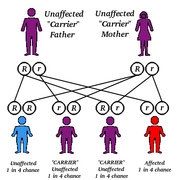Niemann-Pick Disease
Niemann-Pick disease is an inherited condition involving lipid metabolism (the breakdown and use of fats and cholesterol in the body) in which harmful amounts of lipids accumulate in the spleen, liver, lungs, bone marrow, and brain. more...
There are four variants of Nieman-Pick disease based on the genetic cause and the symptoms exhibited by the patient. All variants are inherited in a autosomal recessive pattern.
Mutations in the NPC1, NPC2, and SMPD1 genes cause Niemann-Pick disease.
This condition is inherited in an autosomal recessive pattern, which means two copies of the gene must be altered for a person to be affected by the disorder. Most often, the parents of a child with an autosomal recessive disorder are not affected but are carriers of one copy of the altered gene. If both parents are carriers, there is a one in four, or 25%, chance with each pregnancy for an affected child. Genetic counseling and genetic testing is recommended for families who may be carriers of Niemann-Pick.
Types
Types A and B
Type A Niemann-Pick disease begins during infancy and is characterized by an enlarged liver and spleen (hepatosplenomegaly), failure to thrive, and progressive deterioration of the nervous system. Children affected by this condition generally do not survive past early childhood. Niemann-Pick disease, type A occurs more frequently among individuals of Ashkenazi (eastern and central European) Jewish descent than in the general population. The incidence within the Ashkenazi population is approximately 1 in 40,000 people. The incidence for other populations is unknown.
Type B disease may include signs of hepatosplenomegaly, growth retardation, and problems with lung function including frequent lung infections. Other signs include blood abnormalities such as abnormal cholesterol and lipid levels, and low numbers of blood cells involved in clotting (platelets). People affected by this type of Niemann-Pick disease usually survive into adulthood. Niemann-Pick disease, type B occurs in all populations.
Mutations in the SMPD1 gene cause Niemann-Pick disease, types A and B. This gene carries instructions for cells to produce an enzyme called acid sphingomyelinase. This enzyme is found in the lysosomes (compartments that digest and recycle materials in the cell), where it processes lipids such as sphingomyelin. Mutations in this gene lead to a deficiency of acid sphingomyelinase and the accumulation of sphingomyelin, cholesterol, and other kinds of lipids within the cells and tissues of affected individuals.
Types C1 and C2
Niemann-Pick disease, type C is further subdivided into types C1 and C2, each caused by a different gene mutation. Both types C1 and C2 Niemann-Pick disease are most commonly characterized by onset in childhood, although infant and adult onsets are possible. Other signs include severe liver disease, breathing difficulties, developmental delay, seizures, increased muscle tone (dystonia), lack of coordination, problems with feeding, and an inability to move the eyes vertically. People with this disorder can survive into adulthood. The incidence of Niemann-Pick disease, type C is estimated to be 1 in 150,000 people. The disease occurs more frequently in people of French-Acadian descent in Nova Scotia.
Read more at Wikipedia.org



